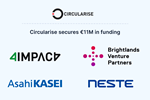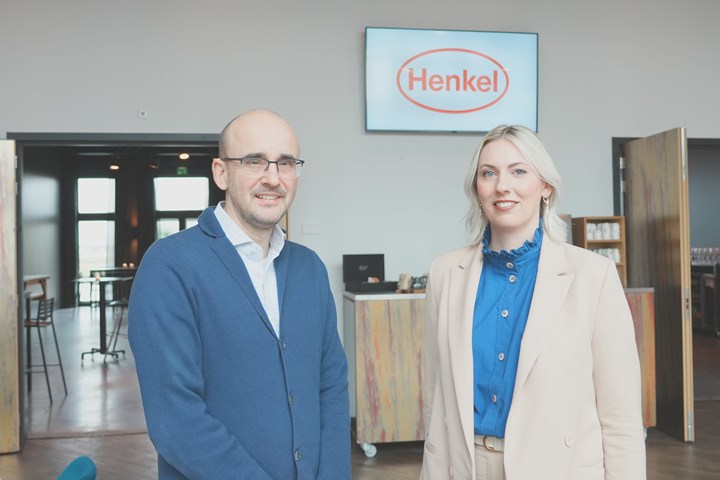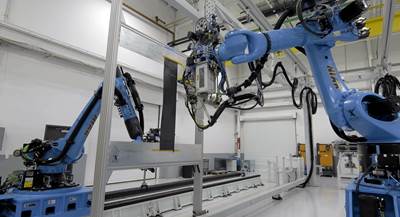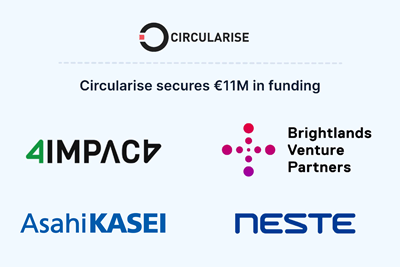Henkel Adhesive Technologies, Bluecrux transform customer-centric supply chain
Composites material supplier embraces digitization as one tool in a plan focused on improving the customer experience, which then adds to its value and competitive advantage.
Bjoern Neal Kirchner from Henkel (left) and Anouk Schoenmakers from Bluecrux (right). Photo Credit: BizClik Media
More than two years ago, Henkel’s (Düsseldorf, Germany) Adhesive Technologies business unit embarked on a journey with consulting firm Bluecrux (Mechelen, Belgium) to transform its operations into a customer-centric supply chain where customer experience is established as a competitive edge.
Founded 146 years ago, Henkel plays a role in nearly 500 global industries with 52,000 international employees. Comprising 50% of the company, Henkel’s Adhesive Technologies business unit is a highly acclaimed adhesive producer, with a mixture of B2B and B2C business and a portfolio of adhesives, sealants and functional coatings.
Recognizing that the trend of supply chain complexity and volatility is increasing, Henkel understood that digitization of the supply chain is inevitable, but that it should have a clear strategy and focus — improving the customer experience. Thus, Henkel not only aims to improve its bottom line, but the top line performance of its customers, thus establishing a competitive advantage.
However, the company needed to translate this into a strong mission and then actualize that mission. Henkel’s mission evolved to focus on three pillars:
- Customer-centricity: Cultivate a customer-centric mindset and cultural change along the entire chain.
- Competitive advantage: Accept customer value as the real North Star.
- Integrated approach: Use digital capabilities to overcome functional views and move toward an integrated supply chain.
Mission, 13 projects, communication, digitization
The ensuing journey required homing in on several different elements, including:
- How the company operated and served its customers.
- The processes that needed to be adjusted.
- New enabling technologies that needed to be embraced.
- Learning how to shift mindsets.
- Setting new metrics to measure what really matters to customers.
Launching this transformation required answers to two key questions: How is the transformation made real? How can everyone at the company be brought on board and buy into this mission?
First, Henkel needed to understand how the company as a team — sales, marketing, supply chain, finance — understood its customers’ experiences and what those customers valued. Through digital workshops and value stream mapping, Henkel and Bluecrux were able to construct 15 summaries regarding the team’s perception of customer experience, some of which were accurate, but some of which were not.
For companies to transform supply chain operations to a real value and competitive advantage, talking with and understanding each customer must be a priority.
Henkel then discovered that what is valued by customers are its innovation, quality and the speed and/or reliability of its supply chain. Going deeper still, Henkel selected a representative set of customers and identified 13 transformation projects. Putting this plan in motion required, crucially, communicating the program across the organization. To do this, a simple picture of the idea was put forward to give colleagues a framework for the changes to come, and instead of unveiling an overwhelming amount of information at once, layers were added to the initiative bit by bit.
Fundamentals were developed, including collecting the necessary data to create new interfaces and improve Henkel’s efficiency layer, which then powered an improved customer experience. Some new technologies were also embraced, but targeted delivering value and making the transformation holistic versus just a shiny appearance.
Three example of transformation
Henkel completed this initial phase in mid-2022. The time it spent in discovery enabled its teams to be well prepared for transformation, bringing everyone on board and nailing down the most vital activities that needed to happen. As Henkel continues on its roadmap, here are three examples that illustrate its transformation.
1. Shaping the customer-centric mindset: Henkel’s entire operating model is evolving to be customer-centric, including transformation of its entire customer service operations. This has included establishing more ownership of the customer experience in local countries, splitting activities between a center of excellence and a shared service center. Job profiles now focus on elements of customer-centricity and Henkel invests in the people that make this a reality.
Training for this mindset goes beyond sharing customer-centricity concepts to conducting concrete exercises that give team members a toolbox and ownership of specific parts of the customer experience. New roles and tailored training plans help grow the capabilities of each team. A new platform was established for team members to share customer conversations and experiences, including challenges and solutions. This resource acts as a support and learning system that then helps Henkel to refine and extend the roadmap to maintain its customer-centric organization and operations.
2. The competitive advantage as a North Star: Henkel and Bluecrux examined the data that customers have at their fingertips and recognized three key truths.
- Customers know when they want something. (The initial requested day)
- They know what they’ve been told. (The communicated day)
- And they know when the item has arrived. (The actual delivery day)
One way Henkel can improve its customers’ experience is by seeking to best align the requested delivery date with what is the most reliable delivery date. There are no incentives to manipulate this data. Instead, the incentive is to align the promise and actual delivery, which then makes tracking, tracing and getting that date correct key fundamentals. While it took Henkel more than a year to get everyone behind this initiative, that time and effort has paid off. After going live with this new system in January 2023, the company says it can already see very different conversations taking place and adherence to this new North Star.
3. Henkel’s differentiators: Henkel has dedicated itself to the process pieces of shipment experience, sampling experience and complaints experience. Instead of seeing them as add-ons, the company is treating these areas as foundational, embedded in its core culture. Process optimization is not done from inside the company but instead from a customer experience perspective.
- Shipment experience: Henkel is providing visibility on where its orders are, including investing in and launching track and trace options all around the world.
- Sampling experience: Ordering samples is often a customer’s first experience with Henkel, so the company launched a project to make this process seamless and easy from a customer perspective.
- Complaints experience: Customer service has generally been registering and closing complaints, stressing how fast they are closed instead of the customer experience. This experience is now Henkel’s focus, understanding it’s not just the problem, but how it’s addressed. One part of this transformation is a new checkpoint process with a workflow of standard communication.
Lessons learned
If it’s not in your company mission, don’t go for it: Henkel has seen first-hand the importance of having a company be aligned for a successful transformation journey. It needs to be supported by the overall aim of the company and have all the necessary backing, all the way from the top. Revitalizing the company strategy to make this customer-centricity real in everything it does requires a strong leader and widespread buy-in. Another key is to talk to customers. In supply chain management, engaging with customers is often not prioritized. But for companies to transform supply chain operations to a real value and competitive advantage, talking with and understanding each customer must be a priority.
Read Next
JEC, ICS promote trade opportunities with U.K. composites sector
A new partnership leverages the International Composites Summit event in September and JEC’s support to facilitate international trade, foster innovation and strengthen economic ties between the U.K. and global composites industries.
Read MorePlataine, NIAR ATLAS partner to promote aerospace innovation, digitalization
Researchers at NIAR ATLAS will examine how Plataine’s technology can help manufacturers and advanced composite material vendors drive further digital transformation while undertaking industry challenges.
Read MoreAsahi Kasei joins investment in supply chain traceability, transparency system
Alongside three other partners, Asahi Kasei helped raise €11 million to accelerate Circularise, a Netherlands startup enabling traceability of information for raw materials recycling, biomass and more.
Read More
















.jpg;maxWidth=300;quality=90)





